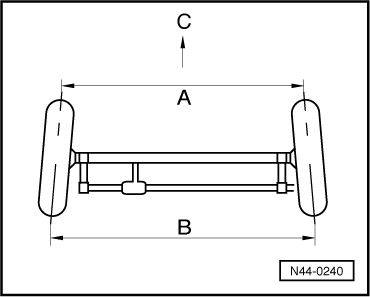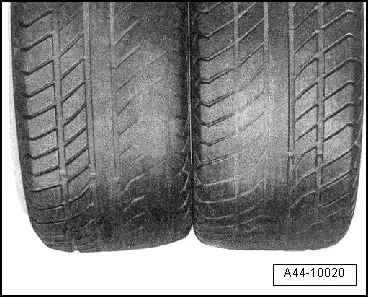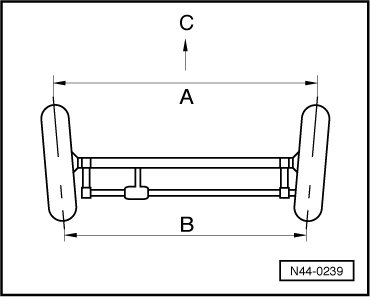| Distance between front of wheels -A- is less than distance between rear of wheels -B- (-C- = direction of travel). |
| To prevent one-sided wear, care must be taken to ensure that the wheel is set within the tolerance specified by the vehicle manufacturer. The most frequent deviation of the wheel alignment is caused by external influences, for example hard contact with the kerbstone when parking. |
| By measuring the axle geometry, you can check whether the wheel alignment is within the specified tolerances or whether it has to be corrected. |
| Running gear modifications |
| Using „suspension-lowering kits“ and/or alloy wheels that have not been recommended by VW may result in altered wheel positions which deviate from the specified alignment. |
| Even if the axle geometry is correct with the vehicle stationary during wheel alignment, the changed vehicle height and wheel positions can cause the wheel suspension to move differently during operation. |
| Uneven wear is then unavoidable. |
| The use of the offroad level is recommended only for driving offroad. Permanent use of the offroad level during normal road operation can lead to increased tyre wear as the height of the wheel position is different to the road level. |
| The way to prevent one-sided tyre wear is to ensure the wheel alignment is correct on one hand and on the other hand to make sure the vehicle is used only for its intended purpose: |
| Regular servicing of the vehicle and tyres helps to prevent tyre wear. The following should be noted in particular with regards to this: |
| t
| The prescribed minimum tyre inflation pressures must be adhered to. |
| t
| Different wear on the front and rear axle depending on the driving style is unavoidable. This condition can be compensated for by rotating the wheels from front to rear. The ideal opportunity to do this, for example, is during the seasonal change between winter and summer tyres. This change also has a positive side effect in that the tyres can wear down equally, meaning that a completely new set of tyres can be fitted. This prevents differences between the tread depths of the tyres on each axle, which can have negative effects on road holding. |
| t
| Saw tooth formation is a normal wear pattern, particularly if the driving style is very careful → Chapter. This can lead to increased rolling noise, which generally becomes better as the tread depth decreases. In the event of light saw tooth formation or if saw tooth formation is just starting, exchanging the wheels between axles is normally sufficient. If saw tooth formation is very pronounced, the wheels have to be changed in accordance with → Chapter so their direction of rotation is reversed. |
| t
| Some tread patterns may create an impression of premature wear: if winter tyre sipes or channels in the tread are worn down, only compact profile blocks without patterns remain, thus giving the impression of a worn tyre. In this case, the remaining tread depth must be measured in each groove. If this is at or below the minimum tread depth, the tyre can continue to be used without restrictions. (In Germany, the minimum is 1.6 mm; it is recommended, and in Austria, required, that winter tyres that are worn down to 4 mm be used only in summer ) |
|
|

|





